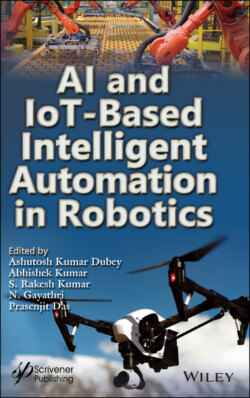Читать книгу AI and IoT-Based Intelligent Automation in Robotics - Группа авторов - Страница 29
2.5 Role of AI and IoT in Robotics
ОглавлениеArtificial intelligence (AI) and Internet of Things (IoT) are the technologies of today and they are becoming more and more advanced day by day. These technologies are in very high demand in the industry as all the innovations taking place are based on them. AI comprises mathematical and statistical models that govern the working of algorithms that are used to develop intelligent systems and the IoT consists of various tools and techniques to effectively manage the sensors and their intercommunications via the use of various protocols and devices. Due to the high capabilities of these technologies, they are highly adopted in industries, healthcare, businesses, and various sectors of the economy [16].
Both of these technologies, when used together, can be much more beneficial as IoT is better at collecting data and AI is a great tool to process huge amounts of data. As IoT uses other technologies like big data or AI for data processing, this implies that AI works on the backend of IoT and plays a major role in working on any system or framework comprising the two [17]. The perfect example can be our voice user interface devices such as Alexa or Google Home. They were trained with some data and that data has been processed via AI whose engine gives output on the basis of data.
Similarly, in robotics, which is a complex system consisting of various types of sensors, various electrical and mechanical devices work together to perform an assigned task. In robotics for the case of recognizing and classifying tasks, it uses computer vision in which the thousands of raw images of objects are fed into machines, and once trained it can classify and recognize objects. In this case, the camera will capture the images from the surrounding (which falls in the IoT domain) and gives it to the ML engine for processing, and once processed the output is shown via actuators or via any output devices.
Some of the major roles of AI and IoT in robotics are:
To program various aspects like learning, understanding, thinking, and inferring based on rules into the robot so as to perform accordingly.
To implement various supervised, unsupervised, semi-supervised, or reinforcement learning algorithms into the robots based on the utility of robots either in industry, business, or for commercial purposes.
To establish various connections between different parts of the robot-like camera connection, wireless modules like Zigbee or Bluetooth, connections between microcontrollers to actuators, etc.
To set up a trained classifier or model so that it can be used by the robot.
To install sensors and actuators so as to sense the environment and perform accordingly.
To create an inference engine for performing inference on the basis of a percept sequence or percept history.
In some cases, to enable speech synthesis so as to talk or control via voice, i.e., voice user interface (VUI) [17].
To establish connections via the cloud so that it can be remotely configured or controlled.
The performance of a robot is governed by its memory or percept sequence and, while training, the model finds some sort of patterns in data that form the basis for learning. While creating a robot there are various aspects that need to be taken care of and the aim is to develop a cognitive architecture in which integration of reasoning, planning, reacting, creating, learning from the past, etc. [18] exists. Inspired by human biology, we try to mimic every biological behavior artificially in robots, like neural networks being built to mimic the behavior of our brain into machines, and various joints being artificially created which were inspired by the human body.
Apart from that, artificial organs are being created to help needy people. Although mimicking the human brain is such a typical task, various companies/researchers are working day and night to build a replacement for the human brain. One such project is SpiNNaker, a machine built at the University of Manchester [19] that is a supercomputer capable of very quickly mimicking a human brain which not only thinks but can create the models of neurons in our brains, and is capable of simulating it in real-time far faster than any other computer in the world [20].
In any IoT-enabled devices [24] which are equipped with sensors (temperature, humidity, pressure, vibration, speed, etc.), percepts are formed of the environment and that information is transferred over the cloud via wireless devices through routers. That data is then input into our android phones or any user interface devices, where the data is then compared with the existing database based on how it performs some actions via actuators, whether it is an alarm, buzzer or fan, to inform the system administrator or user. Then, with the use of AI, the system now acts to resolve the problem on the basis of the percept sequence about the situation stored in the cloud database [16].
